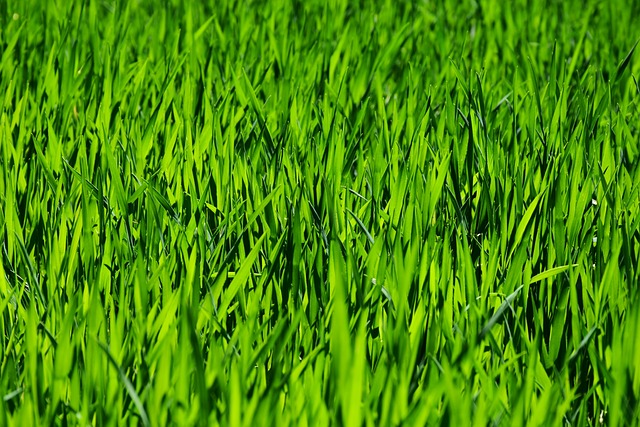Lawn care and landscaping are integral to maintaining a healthy, visually appealing lawn that reflects diligent maintenance. A robust fertilization program with scheduled applications of balanced nutrients like nitrogen, phosphorus, and potassium is essential for grass health, particularly for promoting lush foliage. Tailoring this program to the type of grass and regional climate ensures optimal growth and resilience. A comprehensive approach that includes regular mowing, efficient watering, targeted weed management, and soil testing to avoid over- or under-fertilization further enhances lawn health by preventing issues like soil compaction, pest infestations, and thatch buildup. Adhering to product-specific instructions and environmental regulations ensures a sustainable landscape. Effective weed control involves identifying local weed types, understanding their behaviors, and employing both proactive strategies and targeted treatments to maintain a dense, green lawn free of intrusive weeds. By consistently monitoring and adjusting these practices in response to environmental changes, homeowners can achieve long-term success in lawn care and landscaping, resulting in a lawn that stands out for its beauty and health within any community.
Maintaining a lush, green lawn is a cornerstone of landscaping that reflects both aesthetic appeal and environmental health. This article delves into the intricacies of effective lawn fertilization and strategic weed control to cultivate a vibrant yard. We’ll explore the basics of fertilization, the methods for controlling weeds, and how integrating these practices into a cohesive lawn care routine can lead to a healthier landscape. By understanding the balance between nourishing your grass and managing unwanted plants, you’ll be on your way to mastering lawn care.
- Understanding the Basics of Lawn Fertilization for a Vibrant Yard
- Strategic Weed Control: Methods and Best Practices for a Weed-Free Landscape
- Integrating Fertilization and Weed Control within a Comprehensive Lawn Care Routine
Understanding the Basics of Lawn Fertilization for a Vibrant Yard

A lush, green lawn is a hallmark of well-executed lawn care and landscaping. To achieve this, understanding the basics of lawn fertilization is paramount. Fertilization is the process of providing essential nutrients to your grass, promoting healthy growth and root development. Key macro-nutrients such as nitrogen (N), phosphorus (P), and potassium (K) are found in most fertilizers and play a crucial role in plant health. Nitrogen, for instance, is primarily responsible for leaf growth, ensuring your lawn maintains its vibrant appearance. A balanced fertilization schedule throughout the growing season, which typically includes early spring, mid-summer, and late fall applications, ensures continuous nutrient supply tailored to different grass types and local climates.
Incorporating a comprehensive lawn care and landscaping strategy that includes regular mowing, proper watering, and targeted weed control complements fertilization efforts. Soil testing is also an invaluable tool for understanding your lawn’s specific nutrient needs and for fine-tuning your fertilization plan to avoid over or under-fertilizing. By adhering to a tailored fertilization regimen and addressing potential issues like soil compaction, pests, and thatch accumulation, you can create a thriving landscape that stands out in any neighborhood. Remember to follow the specific instructions on each fertilizer product, as different formulations may have unique application requirements, and always be mindful of local environmental regulations to maintain a healthy, beautiful yard that is both attractive and sustainable.
Strategic Weed Control: Methods and Best Practices for a Weed-Free Landscape

A well-maintained lawn is a testament to meticulous lawn care and landscaping practices, which include strategic weed control. Effective weed management begins with understanding the types of weeds prevalent in the region and their growth patterns. Employing a combination of preventative measures and targeted treatments is crucial for maintaining a weed-free landscape. Preventative strategies involve proper soil preparation, selecting the right grass type for the local climate, and ensuring optimal sunlight and water conditions to foster healthy turf growth that can naturally compete against weeds.
When weeds do emerge, it’s important to address them promptly and appropriately. Hand-weeding is often effective for small infestations, while broader areas may necessitate systemic herbicides applied through fertilization services. These should be chosen based on the specific weed species present and should be used in accordance with label instructions to minimize environmental impact. Additionally, cultural practices such as maintaining proper mowing height, aerating the soil, and overseeding can improve lawn density, making it more resistant to weed invasions. Regular monitoring and a proactive approach to lawn care and landscaping are key to keeping your landscape lush, green, and free of unwanted vegetation.
Integrating Fertilization and Weed Control within a Comprehensive Lawn Care Routine

A robust lawn care and landscaping routine encompasses both fertilization and weed control to maintain a lush, healthy lawn. Fertilization is not merely about feeding the grass; it’s a strategic process that supports soil health, promotes root growth, and enhances the turf’s resilience against environmental stressors. By choosing the right type of fertilizer with appropriate nutrient ratios for your local soil conditions and grass species, you can ensure optimal growth and vibrant color.
Weed control is an integral component that complements fertilization. Effective weed control prevents invasive species from competing with desirable turfgrasses for sunlight, water, and nutrients. Integrating pre-emergent herbicides into the fertilization schedule can inhibit weed seeds from germinating, while post-emergent treatments target existing weeds. This dual approach within a comprehensive lawn care and landscaping routine not only eliminates unsightly weeds but also fosters an environment where grass can flourish, leading to a more uniform and aesthetically pleasing landscape. Regular monitoring and adjustments to both fertilization and weed control practices are essential to adapt to changing conditions and ensure the best outcomes for your lawn.
Effective lawn care and landscaping practices, particularly those concerning fertilization and weed control, are crucial for maintaining a lush and healthy yard. This article has outlined the fundamental aspects of lawn fertilization to promote grass vitality and provided strategic approaches to manage and prevent weed intrusion. Integrating these elements into a cohesive lawn care routine ensures a landscape that is both aesthetically pleasing and resilient against common turfgrass challenges. By understanding and applying the best practices discussed, homeowners can achieve and sustain a thriving outdoor space throughout the seasons.
